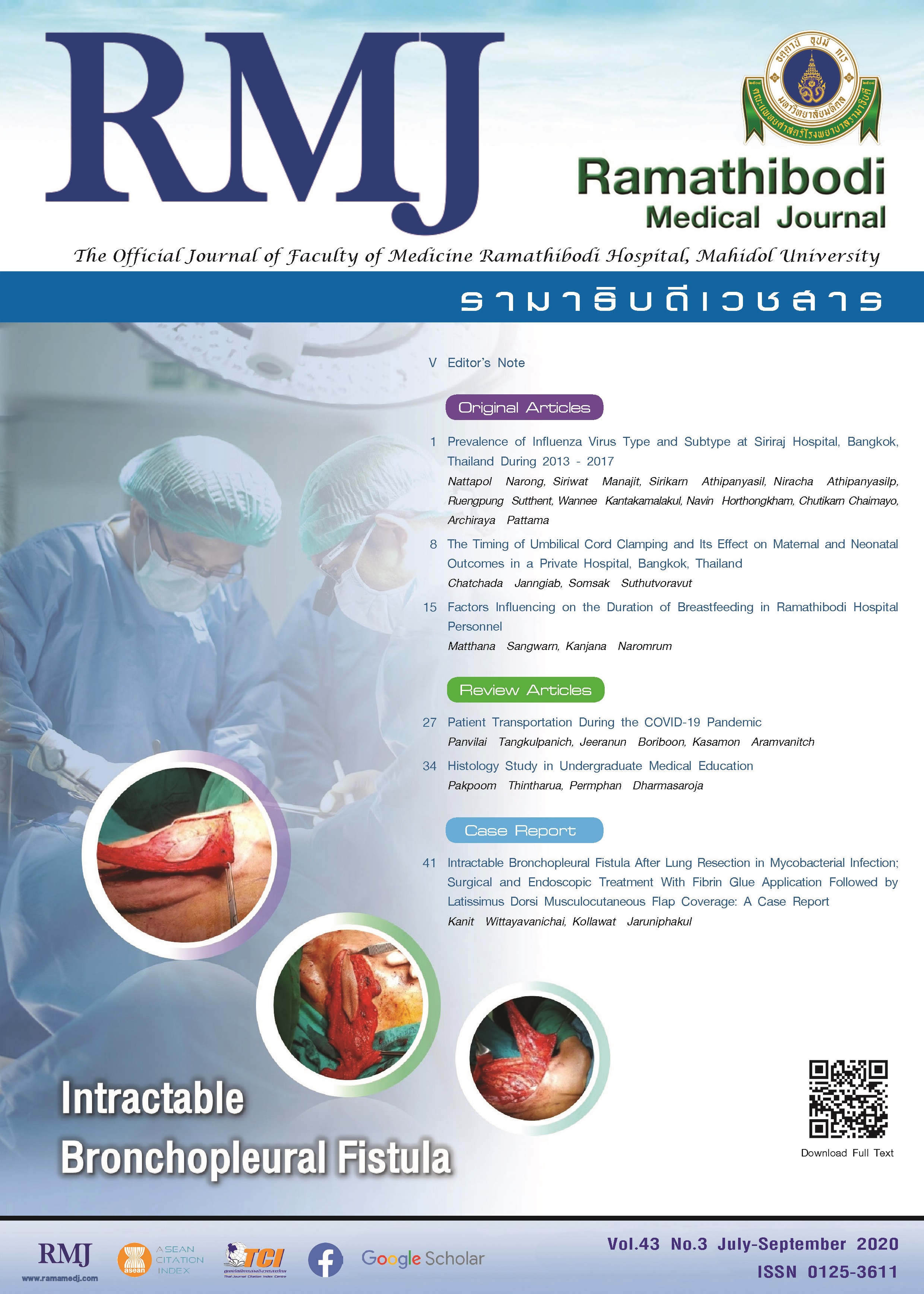Prevalence of Influenza Virus Type and Subtype at Siriraj Hospital, Bangkok, Thailand During 2013 - 2017
DOI:
https://doi.org/10.33165/rmj.2020.43.3.241918Keywords:
Seasonal influenza, Influenza A(H1N1) 2009 virus, Influenza B virusAbstract
Background: Influenza A (pandemic and seasonal H1/H3) and influenza B viruses were the predominant circulating seasonal influenza strains. Following its massive outbreak in 2009 globally, including Thailand, influenza A (H1N1) pdm09 viruses have replaced the previous seasonal H1 strain and become one of the circulating strains ever since. Both influenza A and B viruses are highly contagious and potentially cause respiratory illness ranging from mild to severe.
Objective: To determine the prevalence of types and subtypes of circulating influenza virus strains in Bangkok, Thailand during 2013 - 2017.
Methods: The 4385 nasopharyngeal wash specimens were collected from patients presented with influenza-like illness from January 2013 to December 2017 at Siriraj Hospital, Bangkok, Thailand. Influenza virus types and subtypes were determined using real-time RT-PCR technique. Clinical characteristics of patients infected with influenza A viruses and influenza B virus were compared and analyzed.
Results: Of 4385 nasopharyngeal wash specimens, the prevalence of influenza virus infection during 2013 - 2017 was 18.22% (n = 799). Of 799 influenza-positive samples, 608 (76.09%) and 191 (23.90%) samples were positive for influenza A and influenza B viruses, respectively. Most patients were presented with fever, cough, and runny nose; however, patients infected with influenza A virus generally had higher severity than those with influenza B virus infection (P < .05).
Conclusions: The findings provided the characteristics of influenza virus types and subtypes at Siriraj Hospital, Bangkok, Thailand during 2013 - 2017. Sporadic cases of influenza occurred all year round, but the incidence peaked in March 2014 and August 2017. The outcomes of this study are potentially useful for prevention, treatment, and disease monitoring.
References
Petrova VN, Russell CA. The evolution of seasonal influenza viruses. Nat Rev Microbiol. 2018;16(1):47-60. doi:10.1038/nrmicro.2017.118.
Horthongkham N, Athipanyasilp N, Pattama A, et al. Epidemiological, clinical and virological characteristics of influenza B virus from patients at the Hospital Tertiary Care Units in Bangkok during 2011-2014. PLoS One. 2016;11(7):e0158244. doi:10.1371/journal.pone.0158244.
Kilbourne ED. Influenza pandemics of the 20th century. Emerg Infect Dis. 2006;12(1):9-14. doi:10.3201/eid1201.051254.
Athipanyasilp N, Chaimayo C, Kantakamalakul W, Sutthent N, Horthongkham N, Pattama A. Oseltamivir resistant influenza A viruses in Thailand during 2009-2011. J Med Health Sci. 2019;26(2):65-83.
Lowen AC, Mubareka S, Steel J, Palese P. Influenza virus transmission is dependent on relative humidity and temperature. PLoS Pathog. 2007;3(10):1470-1476. doi:10.1371/journal.ppat.0030151.
Beigel JH. Influenza. Crit Care Med. 2008;36(9):2660-2666. doi:10.1097/CCM.0b013e318180b039.
Markowska-Daniel I, Urbaniak K, Porowski M, et al. Emergence of the pandemic H1N1 2009 influenza A virus in swine herds in Poland. Bull Vet Inst Pulawy. 2013;57(3):293-300. doi:10.2478/bvip-2013-0051.
Masse S, Capai L, Falchi A. Epidemiology of respiratory pathogens among elderly nursing home residents with acute respiratory infections in Corsica, France, 2013-2017. Biomed Res Int. 2017;2017:1423718. doi:10.1155/2017/1423718.
Prachayangprecha S, Makkoch J, Suwannakarn K, et al. Epidemiology of seasonal influenza in Bangkok between 2009 and 2012. J Infect Dev Ctries. 2013;7(10):734-740. doi:10.3855/jidc.2929.
Hayden FG, Atmar RL, Schilling M, et al. Use of the selective oral neuraminidase inhibitor oseltamivir to prevent influenza. N Engl J Med. 1999;341(18):1336-1343. doi:10.1056/NEJM199910283411802.
Choi WS, Cowling BJ, Noh JY, et al. Disease burden of 2013-2014 seasonal influenza in adults in Korea. PLoS One. 2017;12(3):e0172012. doi:10.1371/journal.pone.0172012.
Chen JF, Sun BC, Yuan J, Zhang RS, Ou XH. Surveillance of influenza virus during 2010-2012 in Changsha, China. Southeast Asian J Trop Med Public Health. 2014;45(2):319-325.
Kanchana S, Kanchana S, Prachayangprecha S, Makkoch J, Chantrakul C, Poovorawan Y. Influenza surveillance in southern Thailand during 2009-2010. Southeast Asian J Trop Med Public Health. 2012;43(4):871-876.

















